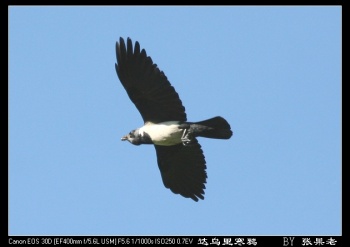Alternative names: Asian Jackdaw; Pied Jackdaw; Black Jackdaw; Collared Jackdaw; Chinese Jackdaw; Eastern Jackdaw
- Corvus dauuricus
Identification
34 - 36cm. A small corvid
- Cream white areas on underparts
- Cream white collar
- Glossed black head, throat, wings and tail
- Grey ear coverts
- Black iris and legs
Sexes similar. Immatures have white parts of plumage replaced by black, similar to Eurasian Jackdaw except for dark eyes and lacking the grey head shawl. They were once described as distinct species ("Corvus neglectus").
Distribution
From east Tibet over central and north China to Mongolia and southern parts of east Siberia. Northern birds migrate south to southeast China, Korea and Japan in winter.
Common but localised in some parts of its range.
Taxonomy
This is a monotypic species[1], which in the past has been considered conspecific with Eurasian Jackdaw. Like the latter, it is now often placed in the genus Coloeus.
Habitat
River valleys, open woodland, hills and mountains. Up to 2000m in the Altai mountains.
Behaviour
Behaviour similar to Eurasian Jackdaw.
Flocks in winter with Rook, Carrion Crow, Hill Pigeon and Yellow-billed Chough.
Diet
The diet includes grains, insects and berries.
Breeding
Breeding starts in February in China, in late May in Tibet and in May in Siberia. Several pairs usually nest together in tree holes or natural cavities. Lays 4 - 6 eggs.
Southern populations are resident while northern populations migrate south in winter.
References
- Clements, JF. 2011. The Clements Checklist of Birds of the World. 6th ed., with updates to August 2011. Ithaca: Cornell Univ. Press. ISBN 978-0801445019. Spreadsheet available at http://www.birds.cornell.edu/clementschecklist/downloadable-clements-checklist
- Del Hoyo, J, A Elliott, and D Christie, eds. 2009. Handbook of the Birds of the World. Volume 14: Bush-shrikes to Old World Sparrows. Barcelona: Lynx Edicions. ISBN 978-8496553507
Recommended Citation
- BirdForum Opus contributors. (2024) Daurian Jackdaw. In: BirdForum, the forum for wild birds and birding. Retrieved 27 July 2024 from https://www.birdforum.net/opus/Daurian_Jackdaw
External Links
GSearch checked for 2020 platform.1





